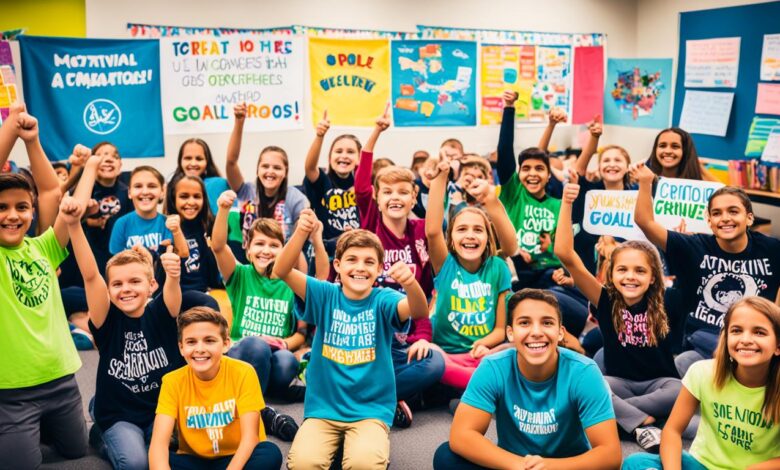Boosting Student Drive with Motivation Techniques

As parents, administrators, and teachers, we all want our students to be driven and motivated in their educational journey. But sometimes, it can feel like a constant uphill battle, especially when faced with the challenges of remote learning. The truth is, student engagement and motivation are essential for academic success and overall well-being. It’s what keeps students pushing forward, even when the going gets tough.
So how can we inspire and motivate our students? How can we boost their morale and encourage them to give their best effort? In this article, we will explore effective motivation techniques for students, discover strategies to inspire and engage them, and learn how to create a supportive classroom environment that fosters motivation. Let’s embark on this journey together and empower our students to thrive!
Key Takeaways:
- Understanding the difference between motivation and engagement is crucial in developing effective strategies.
- Autonomy, competence, and relatedness are key components that contribute to student motivation.
- Creating a supportive and structured classroom environment enhances student engagement.
- Strategies like personalized support, goal-setting, and course relevancy can significantly boost student motivation.
- Faculty development and campus climate assessments play a vital role in nurturing student motivation and engagement.
The Impact of Student Engagement
Engagement is a critical factor in student success. When students are engaged in their education, they achieve higher grades, develop a positive outlook on their future, and are more likely to succeed academically.
A study by Gallup found that students who strongly agree that their school is committed to building their strengths and have at least one teacher who makes them excited about the future are 30 times more likely to report high levels of engagement+. This highlights the profound impact that a supportive and motivating school environment can have on students.
Engaged students are also less likely to experience disciplinary issues, chronic absenteeism, or drop out of school. By fostering student engagement, educational institutions can significantly reduce these challenges and create an environment where students can thrive.
Even in challenging circumstances, a school environment focused on student engagement and motivation can help students maintain hope for the future. With the right support and encouragement, students can overcome obstacles and achieve their goals.
“The future belongs to those who believe in the beauty of their dreams.” – Eleanor Roosevelt
Engaging students goes beyond academic success; it shapes their future outlook and overall well-being. By nurturing student engagement, educational institutions can empower students to reach their full potential and become active contributors to society.
| Benefits of Student Engagement | |
|---|---|
| Higher academic performance | |
| Positive outlook on the future | |
| Reduced disciplinary issues | |
| Lower absenteeism and dropout rates | |
| Improved overall well-being |
The Role of Autonomy, Competence, and Relatedness
Autonomy, competence, and relatedness are three key components that contribute to student motivation. When students have a sense of autonomy, they feel empowered to take initiative and ownership in their actions. This autonomy allows them to make choices and control certain aspects of their learning experience, which increases their intrinsic motivation to engage and excel.
Competence, on the other hand, is the feeling of mastery and the belief that with effort and dedication, a student can succeed and grow. When students have a strong sense of competence, they are more likely to be motivated to tackle challenges, set goals, and persist in the face of obstacles. It is crucial for educators to foster a growth mindset and provide opportunities for students to develop and demonstrate their competence.
Relatedness refers to the sense of belonging and connection that comes from a school setting that conveys respect and caring. When students feel a deep sense of relatedness, they are more engaged and motivated to learn. Building positive relationships and creating a supportive classroom environment that fosters a sense of community is essential for promoting student engagement and motivation.
To enhance student motivation and increase engagement, teachers can create a supportive and personalized classroom environment that enhances autonomy, competence, and relatedness. By nurturing students’ autonomy, providing opportunities for them to excel and grow, and fostering a sense of belonging and connection, educators can empower students to become motivated learners who actively participate and thrive in their academic journey.
By understanding and incorporating the principles of autonomy, competence, and relatedness into their teaching strategies, educators can foster a sense of motivation and engagement in their students, leading to improved learning outcomes and student success.
Classroom Environment and Student Engagement
Creating a supportive classroom environment is crucial for fostering motivation and increasing student engagement. When students feel supported and valued, they are more likely to be motivated and actively participate in their learning. Here are some effective strategies to promote a supportive classroom:
Personalized Learning
Personalizing assignments and incorporating students’ interests can significantly increase motivation and engagement. By allowing students to have a voice and choice in their learning, they feel a sense of ownership and connection to the material. Teachers can tailor lesson plans and activities to meet individual student needs, creating a more engaging and relevant learning experience.
Structured Classroom
A structured and goal-oriented classroom provides students with clear expectations and consistent routines. When students know what is expected of them and have a roadmap for success, they are more likely to stay focused and motivated. Teachers can establish a positive learning environment by setting achievable goals, regularly reviewing progress, and providing constructive feedback.
Collaboration
Collaboration is a powerful tool for increasing motivation and engagement. When students collaborate with their peers, they have the opportunity to share knowledge, help others, and benchmark their own performance. Group projects and discussions can foster a sense of community and create a supportive learning environment where students feel encouraged to actively participate and challenge themselves.
“The classroom should be a place where students feel safe to take risks, ask questions, and explore their curiosity.” – Dr. Maya Johnson, Education Psychologist
By implementing these strategies, teachers can create a classroom environment that supports student autonomy, enhances motivation, and increases student engagement.
Strategies for a Supportive Classroom
| Strategy | Description |
|---|---|
| Personalized Learning | Incorporate students’ interests and tailor assignments to meet individual needs. |
| Structured Classroom | Set clear expectations, establish consistent routines, and provide regular feedback. |
| Collaboration | Promote group projects and discussions to encourage peer learning and support. |
Strategies for Boosting Student Motivation
Enhancing student motivation and engagement is essential for fostering a passion for learning. Here are several strategies that can be employed to support and inspire students:
1. Personalized Support
Providing personalized support is a powerful way to boost student motivation. Utilizing tools like mobile apps and websites can help students set goals, track their progress, and receive feedback tailored to their needs. By offering individualized guidance and assistance, students feel supported and engaged in their learning journey.
2. Autonomy and Competence
Empowering students with autonomy and fostering a sense of competence can greatly enhance motivation. Implementing customized degree planning tools allows students to take ownership of their academic path and make coursework more relevant to their future careers. By creating opportunities for students to demonstrate their competence and mastery, they feel a sense of accomplishment and are motivated to excel.
3. Course Relevancy
Linking coursework to real-world applications can significantly increase student motivation. By highlighting the relevancy of their education, students understand how their learning connects to their future goals. Engaging students through relatable content and incorporating work-integrated learning experiences helps them see the practical value of their studies and ignites their motivation.
4. Faculty Development
Investing in faculty development focused on motivational techniques is vital for enhancing student engagement. Providing teachers with the knowledge and skills to create a classroom environment that supports autonomy, competence, and relatedness promotes motivation and student success. Equipping educators with effective strategies to foster student motivation and engagement ultimately leads to better outcomes.
5. Campus Climate Assessment and Early Alerts
Conducting campus climate assessments and implementing early alert systems can play a crucial role in supporting student motivation and retention. Assessing the overall campus environment helps identify areas for improvement and enables educational institutions to create a positive and motivational culture. Early alert systems allow for timely intervention and support for at-risk students, helping them stay on track and fostering their motivation to succeed.
“Motivation is the fuel that drives students towards success. By providing personalized support, promoting autonomy and competence, emphasizing course relevancy, investing in faculty development, and utilizing campus climate assessments and early alerts, educational institutions can create an environment that fosters student motivation, engagement, and achievement.”
Summary Table – Strategies for Boosting Student Motivation
| Strategy | Description |
|---|---|
| Personalized Support | Utilize tools for goal-setting and progress-tracking |
| Autonomy and Competence | Empower students with customized degree planning and opportunities to demonstrate mastery |
| Course Relevancy | Link coursework to real-world applications and incorporate work-integrated learning |
| Faculty Development | Invest in training and support for teachers in motivational techniques |
| Campus Climate Assessment and Early Alerts | Assess the campus environment and provide timely support for at-risk students |
Implementing these strategies can have a profound impact on student motivation and engagement. By adopting a holistic approach that considers personalized support, autonomy, competence, course relevancy, and faculty development, educational institutions can empower students to thrive and succeed.
Competence Feedback and Motivation
Providing competence feedback is a powerful tool to fuel student motivation and promote continuous progress. When educators offer frequent and precise feedback that reinforces students’ progress, it creates a sense of accomplishment and boosts their confidence. This positive feedback loop plays a crucial role in motivating students to stay engaged and committed to their learning journey.
One effective strategy to enhance student motivation is progress monitoring. By tracking individual advancement and sharing progress reports with students, educators empower learners to see their growth over time. This incremental goal-setting approach allows students to celebrate small victories and build self-efficacy, the belief in their ability to succeed. As self-efficacy grows, so does their motivation to persevere and achieve higher levels of competence.
Incorporating feedback loops into teaching strategies helps students gain a clear understanding of their progress and areas for improvement. By highlighting strengths and providing constructive guidance for growth, educators nurture a sense of mastery in their students. This self-efficacy contributes significantly to motivation, as students become more confident in their ability to tackle challenges and achieve success.
“Competence feedback serves as a compass that guides students on their educational journey, providing them with the necessary direction and motivation to persist and excel.”
Competence feedback not only recognizes students’ accomplishments but also helps them develop a growth mindset. By highlighting specific areas of improvement, educators encourage students to embrace challenges as opportunities for growth. This fosters a sense of perseverance and resilience, as students view setbacks as temporary obstacles rather than insurmountable barriers.
Ultimately, competence feedback creates an environment that supports students’ motivation to succeed. As they receive recognition for their progress and understand their potential for growth, students become more motivated to pursue higher levels of achievement. They develop a lifelong love of learning, driven by their own intrinsic motivation and a sense of personal competence.
Fueling Motivation Through Competence Feedback:
| Benefits of Competence Feedback | Strategies to Implement Competence Feedback |
|---|---|
|
|
Autonomy and Motivation
In order to foster student motivation, autonomy plays a crucial role. By allowing students to have a sense of control over their own learning experience, such as choosing assignments and pacing their learning, intrinsic motivation is enhanced. Customizable curriculums and flexible learning options give students a sense of ownership and empowerment in their education.
Virtual tools and technologies further contribute to autonomy by providing students with agency over their learning pathways. With the ability to navigate and explore educational resources independently, students can tailor their learning experience to suit their individual needs and preferences. This personalized approach to learning increases intrinsic motivation and engagement.
Research has shown that autonomy-supportive environments positively impact student motivation and learning outcomes. According to an article by ASCD, autonomy is one of the secrets to motivation, along with belonging, competence, and meaning [source]. When students have the freedom to make choices and take ownership of their education, they are more likely to be motivated to actively participate and engage in their learning.
An autonomy-supportive classroom environment encourages student-tailored assignments and flexible pacing. By providing options and allowing students to have a say in their learning journey, teachers can tap into the students’ intrinsic motivation, resulting in increased engagement and academic success.
Relevancy and Motivation
When it comes to motivating students, relevance is key. Making coursework relatable to their future career aspirations can greatly enhance their motivation to learn and succeed. By demonstrating how their education applies to real-world applications, students can see the value and expectancy of their learning journey.
One effective way to foster relevance is by incorporating relatable content into the curriculum. By using examples, case studies, and scenarios that students can relate to, educators can create meaningful connections between the subject matter and students’ personal experiences and interests.
“Relevant content allows students to see the practical applications of what they’re learning in the classroom. It bridges the gap between theory and practice, making the subject matter more engaging and motivating.”
Furthermore, integrating work-integrated learning experiences can significantly impact student motivation. Work-integrated learning emphasizes authentic learning experiences and the practical application of knowledge. By providing opportunities for students to apply what they learn in real-world settings, they can grasp the relevancy of their studies and understand how their education directly contributes to their future careers.
Work-integrated learning not only enhances the relevancy of coursework but also helps students develop essential skills and gain hands-on experience. Whether it’s through internships, cooperative education programs, or industry partnerships, these experiential learning opportunities provide students with a taste of the real world, motivating them to excel academically.
“Work-integrated learning enables students to bridge the gap between theory and practice, preparing them for the challenges and expectations of their future careers.”
In summary, incorporating relevant content and work-integrated learning experiences into the curriculum plays a crucial role in boosting student motivation. By creating connections to the real world and providing opportunities for practical application, educators can inspire students and ignite a passion for learning.
Faculty Development and Motivational Techniques
Faculty development plays a pivotal role in enhancing student motivation and engagement. By equipping teachers with effective motivational techniques, we empower them to create dynamic and inspiring learning environments. Autonomy-supportive teaching methods are key to nurturing intrinsic motivation in students.
“Empowering students to take ownership of their learning journey is essential for fostering motivation and engagement.” – Dr. Sarah Johnson, Education Expert
Autonomy-supportive teaching involves providing meaningful rationales for assignments, offering choices, and minimizing pressure. Through continuous education on evidence-based motivational techniques, faculty members are equipped with the knowledge and skills to create student-centered learning experiences.
“When students feel a sense of control and autonomy in their learning, they are more likely to be motivated to explore, discover, and succeed.” – Dr. Michael Adams, Motivational Psychologist
Empowering Diverse Learners
To meet the needs of diverse learners, faculty development programs focus on understanding contemporary motivational approaches. This knowledge positively impacts classroom dynamics, teacher-student relationships, and student motivation, achievement, and retention.
- Educators learn strategies to foster a supportive and inclusive learning environment where every student’s voice is heard and valued.
- By embracing autonomy-supportive teaching, faculty members create a culture that encourages students to take ownership of their learning.
- By offering choices and flexibility, educators cater to different learning preferences and empower students to make meaningful decisions about their educational journey.
Building Motivation through Collaboration
Collaboration is an essential aspect of fostering student motivation. Faculty development programs emphasize the importance of collaborative learning experiences. By providing opportunities for students to share knowledge, help one another, and benchmark their performance, educators create an environment that sparks motivation and engagement.
| Benefits of Collaboration | Examples |
|---|---|
| Enhanced understanding and retention | Group discussions, peer feedback, and collaborative projects |
| Developing teamwork and communication skills | Group presentations, case studies, and group problem-solving |
| Increased motivation and engagement | Collaborative research projects, debates, and simulations |
“Collaboration allows students to learn from one another, develop problem-solving skills, and build meaningful connections with their peers, all of which contribute to enhanced motivation and engagement.” – Dr. Karen Roberts, Education Consultant
Faculty development programs encourage educators to design collaborative learning experiences that align with course objectives and promote student motivation. By leveraging the power of collaboration, teachers can inspire students and foster a sense of camaraderie in the classroom.
Campus Climate Assessment and At-Risk Identification
Campus climate assessment and at-risk identification play vital roles in supporting student retention and motivation. Conducting validated climate surveys allows educational institutions to pinpoint areas for improvement and enhances the overall culture and motivation on campus [source]. By understanding the current climate, institutions can identify potential challenges and implement targeted interventions to create a more supportive and motivating environment for all students.
Analytics and early alert systems are valuable tools that enable institutions to identify at-risk students who may be struggling academically or emotionally. Identifying these students early on allows educators to provide timely support and interventions that can help them overcome obstacles and stay on track towards success. By addressing the specific needs of at-risk students, institutions can improve their retention rates and foster a sense of motivation and belonging.
Implementing comprehensive campus climate assessments and robust at-risk identification systems helps institutions proactively support student success. By creating a positive and inclusive campus environment, educational institutions can enhance student motivation, engagement, and overall well-being, ultimately leading to improved student retention and success.

Conclusion
Boosting student drive and engagement is vital for their academic success. To achieve this, it is crucial to create a supportive classroom environment that fosters motivation and student engagement. By providing personalized support and enhancing autonomy and competence, educators can empower students to take ownership of their learning journey. Additionally, demonstrating the relevancy of coursework through real-world applications and work-integrated learning experiences can ignite students’ passion for learning.
Offering competence feedback and promoting relatedness within the classroom can further fuel student motivation. Implementing strategies such as personalized tools, customized degree planning, faculty development, and campus climate assessments can significantly enhance student engagement. By leveraging these multifaceted approaches, educational institutions can cultivate a love for learning, leading to academic success and a brighter future for students.
Ultimately, by implementing proven motivation techniques for students, we can boost their drive, enhance student engagement, and pave the way for their academic success. It is through these collective efforts that we can empower students to become lifelong learners and thrive in their educational endeavors.






